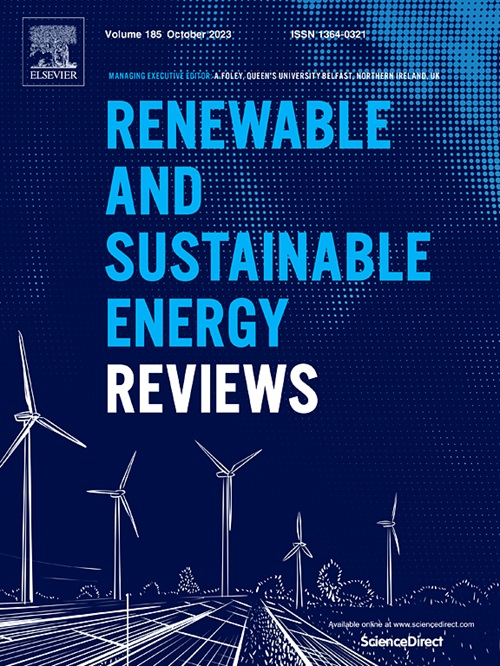Self-healing multi-agent techniques in electric power distribution systems: A review
IF 16.3
1区 工程技术
Q1 ENERGY & FUELS
引用次数: 0
Abstract
In the context of increasing complexity in power distribution networks, the development of self-healing systems has become essential. Interest and research in this area have grown significantly in recent years. The integration of self-healing capabilities has transformed the structure and operation of both conventional and smart distribution networks, particularly affecting protection and protection coordination systems. This paper presents a comprehensive review of the objectives, functions, applications, challenges, and recent advancements in self-healing technologies aimed at improving the control and operation of distribution systems. It also explores the technological and structural components that support self-healing management in smart grids. This paper focuses in particular on the role of self-healing in protection, protection coordination, fault location and isolation, system restoration, and power flow and voltage control. The study evaluates self-healing frameworks based on multi-agent systems for both control and protection in distribution networks. In these frameworks, primary protection relies on peer-to-peer communication among zone agents to detect and isolate faults efficiently. The main functions of these frameworks also include system monitoring, fault diagnosis and location, and effective grid restoration following fault isolation. Additionally, the paper reviews various self-healing control methodologies and strategies designed to enhance the performance of smart distribution systems, with a special focus on protection and coordination. The role of information and communication technologies, software tools, and measurement systems in achieving effective self-healing is also discussed. Furthermore, recent optimization techniques addressing self-healing challenges in distribution networks are examined. Finally, industrial challenges, such as communication delays and cyberattack threats, are discussed, followed by an analysis of existing research gaps and prospective directions for future work. A total of 147 relevant articles, including the most recent publications, have been analyzed. This review aims to serve as a rich and valuable source for those interested in developing the protection, control, operation, and reliability of power distribution systems through self-healing and multi-agent approaches.
配电系统中自愈多智能体技术综述
在配电网络日益复杂的背景下,自愈系统的发展变得至关重要。近年来,对这一领域的兴趣和研究显著增长。自我修复能力的整合已经改变了传统和智能配电网的结构和运行,特别是影响了保护和保护协调系统。本文全面综述了自愈技术的目标、功能、应用、挑战和最新进展,旨在改善配电系统的控制和运行。它还探讨了支持智能电网自我修复管理的技术和结构组件。本文重点研究了自愈在保护、保护协调、故障定位与隔离、系统恢复、潮流与电压控制等方面的作用。该研究评估了基于多智能体系统的配电网络控制和保护的自修复框架。在这些框架中,主保护依赖于区域代理之间的点对点通信来有效地检测和隔离故障。这些框架的主要功能还包括系统监控、故障诊断和定位以及故障隔离后的有效电网恢复。此外,本文回顾了各种自我修复控制方法和策略,旨在提高智能配电系统的性能,特别关注保护和协调。信息和通信技术,软件工具和测量系统在实现有效的自我修复中的作用也进行了讨论。此外,最近的优化技术解决自我修复的挑战,在配电网进行了审查。最后,讨论了通信延迟和网络攻击威胁等行业挑战,然后分析了现有研究差距和未来工作的预期方向。总共分析了147篇相关文章,包括最近的出版物。这篇综述旨在为那些有兴趣通过自愈和多智能体方法开发配电系统的保护、控制、运行和可靠性的人提供丰富和有价值的资源。
本文章由计算机程序翻译,如有差异,请以英文原文为准。
求助全文
约1分钟内获得全文
求助全文
来源期刊

Renewable and Sustainable Energy Reviews
工程技术-能源与燃料
CiteScore
31.20
自引率
5.70%
发文量
1055
审稿时长
62 days
期刊介绍:
The mission of Renewable and Sustainable Energy Reviews is to disseminate the most compelling and pertinent critical insights in renewable and sustainable energy, fostering collaboration among the research community, private sector, and policy and decision makers. The journal aims to exchange challenges, solutions, innovative concepts, and technologies, contributing to sustainable development, the transition to a low-carbon future, and the attainment of emissions targets outlined by the United Nations Framework Convention on Climate Change.
Renewable and Sustainable Energy Reviews publishes a diverse range of content, including review papers, original research, case studies, and analyses of new technologies, all featuring a substantial review component such as critique, comparison, or analysis. Introducing a distinctive paper type, Expert Insights, the journal presents commissioned mini-reviews authored by field leaders, addressing topics of significant interest. Case studies undergo consideration only if they showcase the work's applicability to other regions or contribute valuable insights to the broader field of renewable and sustainable energy. Notably, a bibliographic or literature review lacking critical analysis is deemed unsuitable for publication.
 求助内容:
求助内容: 应助结果提醒方式:
应助结果提醒方式:


